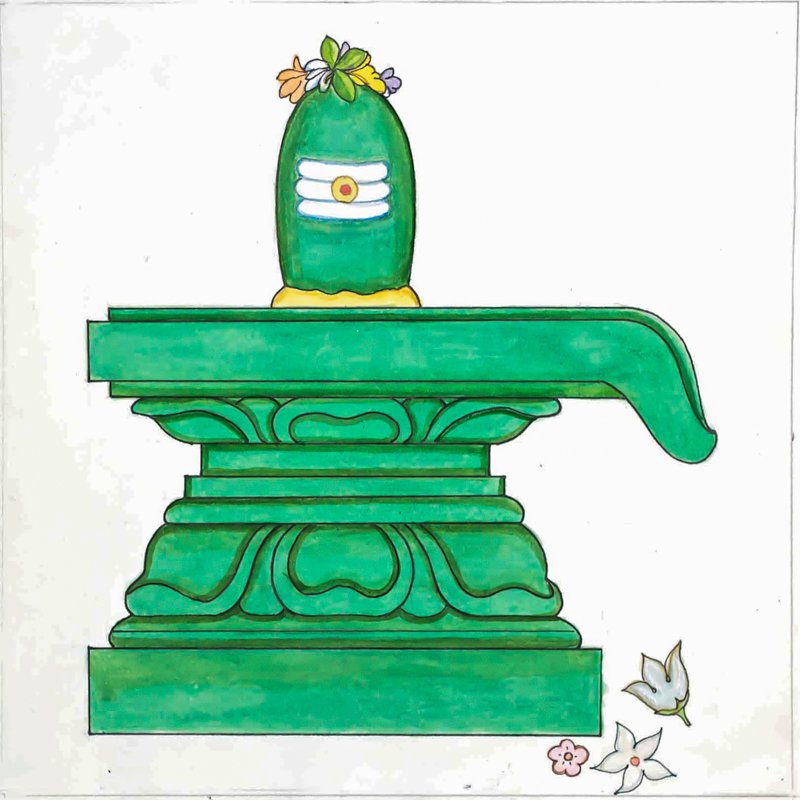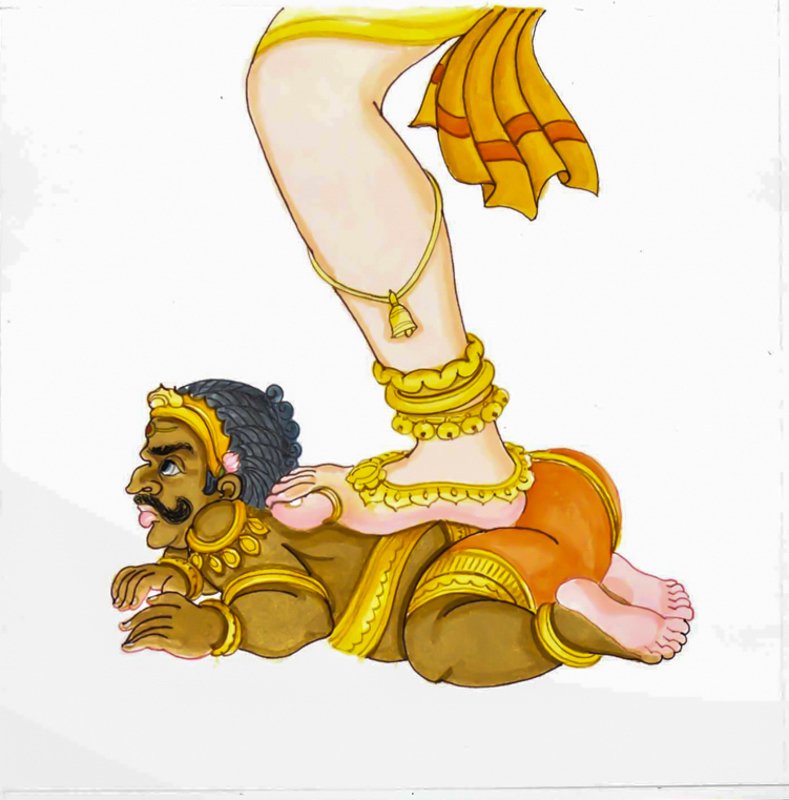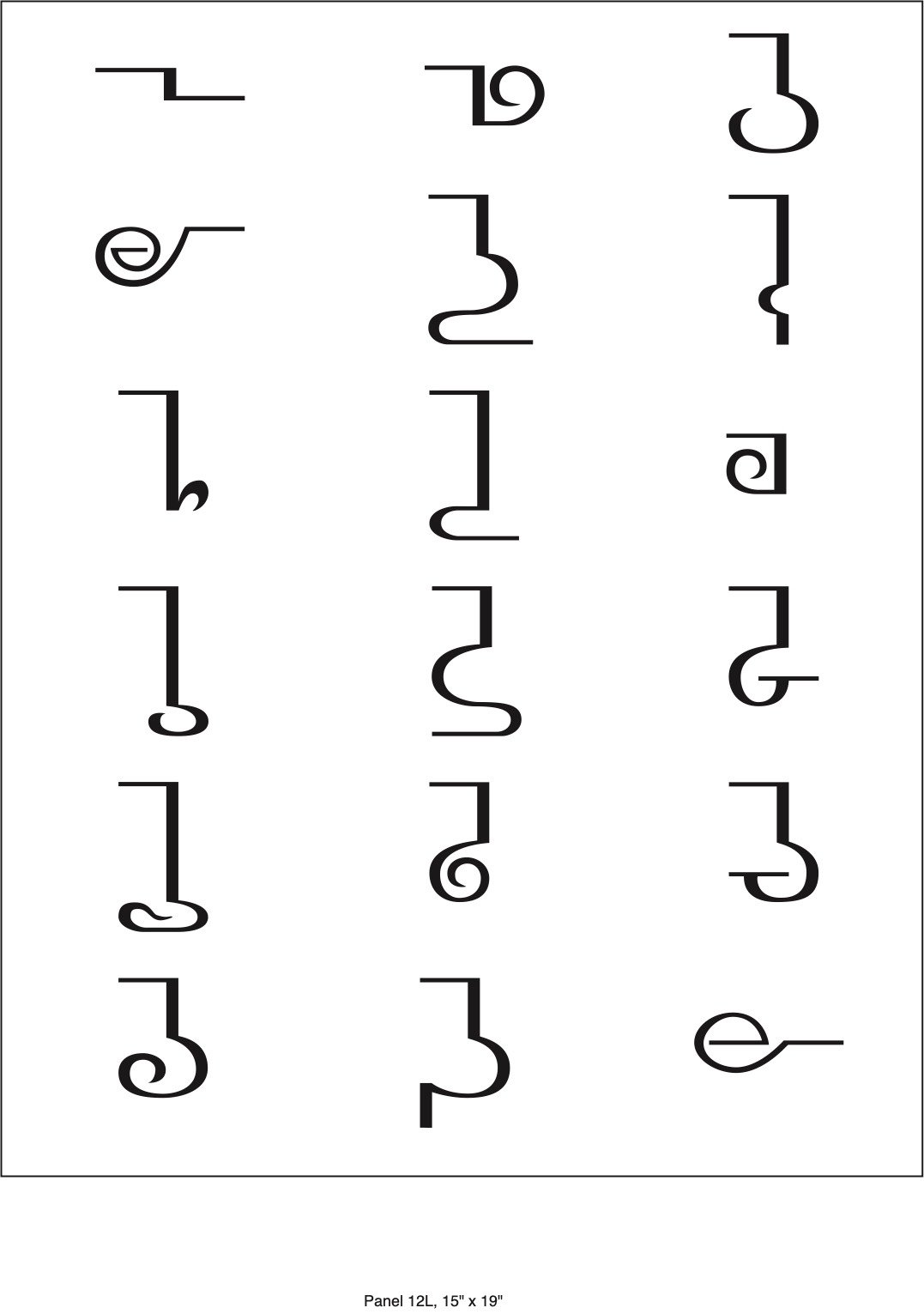Pillar Thirteen
Artwork by A. Manivelu
Top

NORTH FACE:
Tamarind LeafThis is the tamarind leaf and fruit, Tamarindus indica, a leguminous tree bearing edible fruit that is indigenous to tropical Africa. The tamarind tree produces pod-like fruit that contains a brown, edible pulp used in cuisines around the world. The pulp is also used in traditional medicine and as a metal polish. The tree’s wood can be used for woodworking, and tamarind seed oil can be extracted from the seeds. Tamarind’s tender young leaves are used in Indian cuisine, especially in Andhra Pradesh and Telangana. Because tamarind has multiple uses, it is cultivated around the world in tropical and subtropical zones. There is a mature tree near Bali Hai Waterfall, not far from Iraivan Temple.This is the tamarind leaf and fruit, Tamarindus indica, a leguminous tree bearing edible fruit that is indigenous to tropical Africa. The tamarind tree produces pod-like fruit that contains a brown, edible pulp used in cuisines around the world. The pulp is also used in traditional medicine and as a metal polish. The tree’s wood can be used for woodworking, and tamarind seed oil can be extracted from the seeds. Tamarind’s tender young leaves are used in Indian cuisine, especially in Andhra Pradesh and Telangana. Because tamarind has multiple uses, it is cultivated around the world in tropical and subtropical zones. There is a mature tree near Bali Hai Waterfall, not far from Iraivan Temple.

EAST FACE:
Jnana MudraThis hand gesture is called jnana mudra (also known as chin mudra and yoga mudra), in which the thumb and index finger touch, forming a circle, with the other fingers extended.

SOUTH FACE:
SivalingamThis is the Sivalingam, “mark,” “token” or “sign of God Siva.” The most prevalent emblem of Siva, found in virtually all Siva temples. A rounded, elliptical, aniconic image, usually set on a circular base, the Sivalingam is the simplest and most ancient symbol of Siva, especially of Parasiva, God beyond all forms and qualities. The base, or pitha, represents Parasakti, the manifesting power of God. Lingas are usually of stone (carved or naturally existing, such as shaped by a swift-flowing river), but may also be of metal, precious gems, crystal, wood, earth or transitory materials such as ice. According to the Karana Agama (verse 6), a transitory Sivalingam may be made of 12 different materials: sand, rice, cooked food, river clay, cow dung, butter, rudraksha seeds, ashes, sandalwood, dharba grass, a flower garland or molasses.

WEST FACE:
SevalSeval is the large red fighting rooster (kukkuta in Sanskrit) that adorns Lord Murugan’s flag, heralding the dawn of wisdom and the conquest of the forces of ignorance.
1 of 4
Middle

NORTH FACE:
AnavaHere we have Siva’s foot on a man’s back to represent anava, which means “fragment; atom; minuteness, individuality.” Anava is the veiling power that provides individualness, or ego, to each soul, making the soul seem separate and distinct from God and the universe. The ego, sense of “I” and “mine,” ignorance; separation from God. Denotes a sense of finitude and individuality. Derived from the word anu, meaning an atom or something exceedingly small. One of the three malas or bondages: anava, karma and maya. Anava is the cause of the soul’s mistaken sense of separation from God Siva, and the last bond broken at union or Self-Realization.

EAST FACE:
KarmaHere we have a representation of karma, where at the top a person gives a gift and later, at the bottom receives a gift from someone. Karma means “action, deed.” It is among the most important principles in Hindu thought, referring to 1) any act or deed; 2) the principle of cause and effect; 3) a consequence or “fruit of action” (karmaphala) or “after effect” (uttaraphala), which sooner or later returns upon the doer. What we sow, we shall reap in this or future lives. Selfish, hateful acts (papakarma or kukarma) will bring suffering. Benevolent actions (punyakarma or sukarma) will bring loving reactions. Karma is a neutral, self-perpetuating law of the inner cosmos, much as gravity is an impersonal law of the outer cosmos. In fact, it has been said that gravity is a small, external expression of the greater law of karma. The impelling, unseen power of one’s past actions is called adrishta. The law of karma acts impersonally, yet we may meaningfully interpret its results as either positive (punya) or negative (papa)—terms describing actions leading the soul either toward or away from the spiritual goal. Karma is further graded as: white (shukla), black (krishna), mixed (shukla-krishna) or neither white nor black (ashukla-akrishna). The latter term describes the karma of the jnani, who, as Rishi Patanjali says, is established in kaivalya, freedom from prakriti through realization of the Self. Similarly, one’s karma must be in a condition of ashukla-akrishna, quiescent balance, in order for liberation to be attained. This equivalence of karma is called karmasamya, and is a factor that brings malaparipakam, or maturity of anava mala. It is this state of resolution in preparation for samadhi at death that all Hindus seek through making amends and settling differences. Karma is threefold: sanchita, prarabdha and kriyamana.—sanchita karma, as shown on other pillars.

SOUTH FACE:
MayaThis man is looking at a rope but seeing it as a snake. This is a metaphor for maya, illusion. Maya literally means “she who measures;” or “mirific energy.” The substance emanated from Siva through which the world of form is manifested. Hence all creation is also termed maya. It is the cosmic creative force, the principle of manifestation, ever in the process of creation, preservation and dissolution. Maya is a key concept in Hinduism, originally meaning “supernatural power; God’s mirific energy,” often translated as “illusion.” The Upanishads underscore maya’s captivating nature, which blinds souls to the transcendent Truth. In Adi Sankara’s Vedantic interpretation, maya is taken as pure illusion or unreality. In Saivism it is one of the three bonds (pasha) that limit the soul and thereby facilitate its evolution. For Saivites and most other nondualists, it is understood not as illusion but as relative reality, in contrast to the unchanging Absolute Reality. In the Saiva Siddhanta system, there are three main divisions of maya, the pure, the pure-impure and the impure realms. Pure or shuddha maya consists of the first five tattvas—Siva tattva, Shakti tattva, Sadashiva tattva, Ishvara tattva and Shuddhavidya tattva. The pure-impure realm consists of the next seven tattvas. The impure realm consists of the maya tattva and all of its evolutes—from the kala tattva to prithivi, the element earth. Thus, in relation to the physical universe, maya is the principle of ever-changing matter. In Vaishnavism, maya is one of the nine shaktis of Vishnu.

WEST FACE:
MokshaHere we see a cow who has been fettered with a rope, tied to a post. But the rope has broken, representing moksha, “liberation”—release from transmigration, samsara, the round of births and deaths. Moksha occurs after karma has been resolved and nirvikalpa samadhi—realization of the Self, Parasiva—has been attained. Synonymous with mukti.
1 of 4
Bottom

NORTH FACE:
UmamaheswaraThis is the form of God Siva as Umamaheswara, the Divine Mother of the Universe, standing on the Earth which She protects.

EAST FACE:
Basic Shum alphabetThis is the basic Shum alphabet—its first 18 letters and sounds. It is a meditation in Gurudeva’s language of meditation and one of the 12 meditations he asked us to carve on the pillars. The letters begin from the top of the left column: ee, mm, ing, ling, li, ni, ka, sim, vum, reh, tya, ah, bi, oo, na, si, di, shum.
1 of 2
